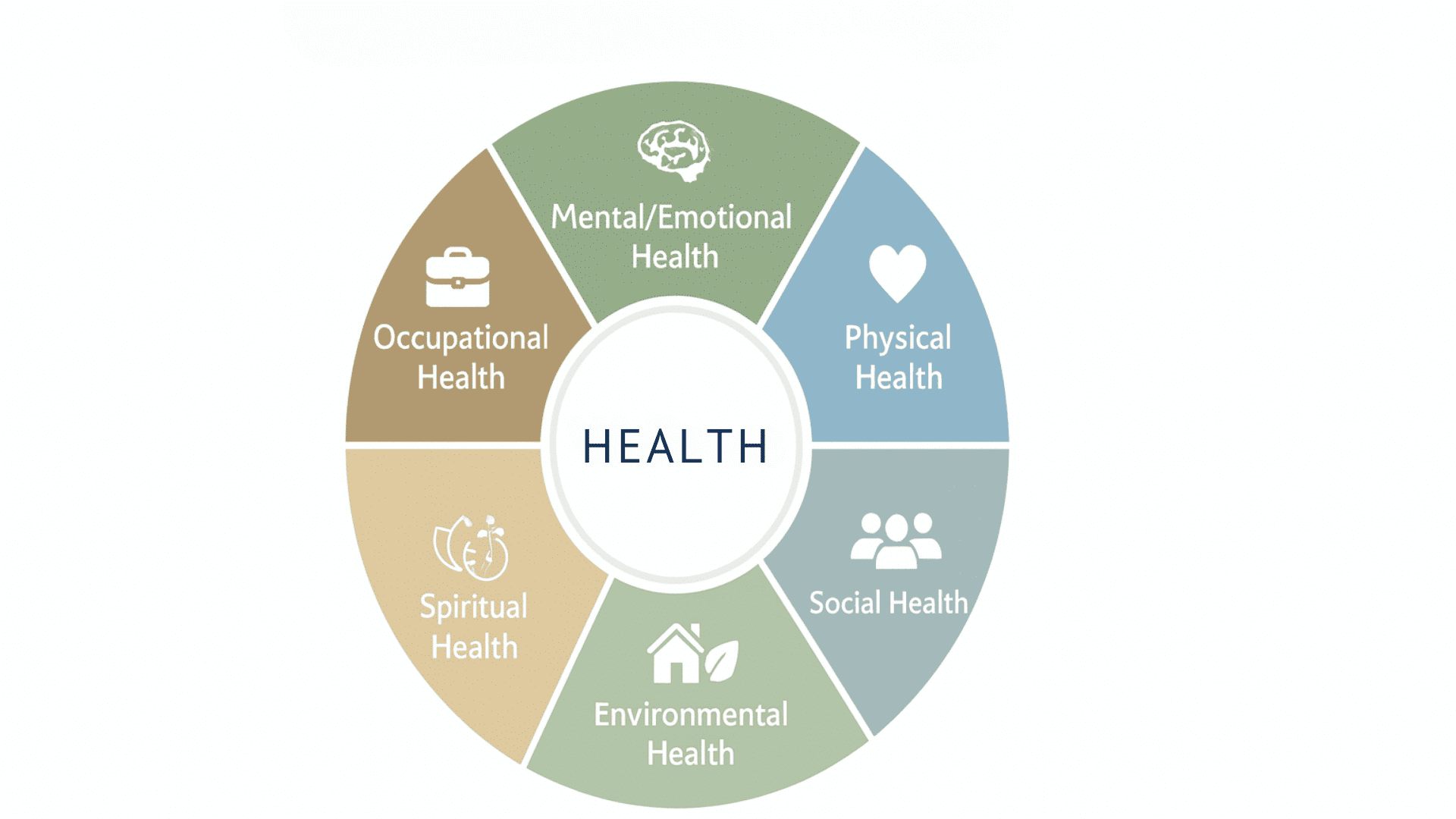Understanding the relationship between health and wellness is key to moving beyond basic health maintenance to true life fulfillment. The components of health are related to wellness through a synergistic system.
Where physical, mental, social, spiritual, environmental, and occupational dimensions intersect to create optimal life satisfaction and functioning, strengthening one component naturally enhances the others.
Whether you’re looking to improve your overall well-being or understand why some areas of your life feel out of balance, grasping these connections will transform your approach to personal development.
By the end of this guide, you’ll have both the knowledge and tools to assess your current wellness state and create meaningful improvements.
What Health and Wellness Really Mean
Before exploring the connections, it’s essential to understand what we’re actually discussing.
Health components: These are the individual dimensions of human functioning, which can be thought of as the building blocks or ingredients of well-being.
Traditionally, these have been addressed separately by different professionals: doctors focus on physical health, therapists on mental health, and so on.
Wellness: This is the dynamic state of optimal functioning across all dimensions of life. Think of it as the finished product when all components work harmoniously together.
The modern understanding of wellness necessitates integration, not just the optimization of individual components.
For example: A person might have excellent physical fitness and stable finances but struggle with loneliness and lack of purpose. They’re healthy in some components but lack overall wellness integration.
The 6 Core Components of Health
These are the 6 core health components that are important and related to overall wellness.
1. Physical Health Component
Physical health includes cardiovascular fitness, strength, nutrition, sleep, and disease prevention. Physical health isn’t just about looking good; it’s your body’s capacity to support your dreams and daily activities.
When your physical health is strong, you have the energy to nurture relationships, pursue meaningful work, and handle life’s challenges with resilience.
Its wellness contribution: This is responsible for providing the energy foundation for pursuing goals in all other areas of life.
2. Mental/Emotional Health Component
Mental and emotional health encompasses stress management, emotional regulation, cognitive clarity, and psychological resilience.
When your mental health is stable, you approach problems as opportunities rather than threats, make clearer decisions, and maintain better relationships across all life domains.
Its wellness contribution: This provides the your ability to make good decisions and maintain healthy relationships.
3. Social Health Component
Social health includes relationship quality, communication skills, community connections, and social support systems.
It provides the human connections that give life meaning and offer support during difficult times. Humans are wired for connection, and social health affects everything from immune function to career success.
Its wellness contribution: This reduces stress, boosts resilience, and creates supportive networks that enrich overall wellness.
4. Spiritual Health Component
Spiritual health encompasses your sense of purpose, alignment with your values, meaning-making, and connection to something greater than yourself, whether religious or secular.
Spiritual health is about having a clear sense of what matters most to you. When your spiritual health is strong, it guides decision-making in all other areas of life and provides motivation during challenging times.
Its wellness contribution: Provides purpose and direction, anchoring decisions and resilience.
5. Environmental Health Component
Environmental health encompasses your physical surroundings, air quality, access to nature, exposure to toxins, and the organization of your home and workspaces.
It directly impacts mood, cognitive function, and stress levels through your surroundings. Your environment either supports or undermines your wellness efforts, it’s not just a background factor.
A cluttered, toxin-heavy environment creates constant low-level stress that affects your mental clarity, physical health, and ability to focus on personal development.
Its wellness contribution: This creates surroundings that either support or undermine wellness efforts.
6. Occupational Health Component
Occupational health includes career satisfaction, skill development, work-life balance, financial wellness, and professional growth. It affects how you spend most waking hours and your sense of contribution to society.
Occupational health influences your identity, stress levels, and resources available for other wellness areas. When your work aligns with your values and provides opportunities for growth, it enhances your overall wellness.
Its wellness contribution: This brings balance, growth, and stability that ripple into all other health areas.
Now that you understand each component, here’s where the magic happens in their connections.
How Components and Wellness Are Interconnected?
The Ripple Effect Principle
Changes in one component automatically influence others through biological and psychological pathways. Research indicates that stress has a direct impact on physical health, sleep quality, and social well-being.
For example: When you improve sleep, you naturally gain better emotional regulation, make better food choices, have more patience with family (social), and feel more optimistic about your future.
The Synergy Effect
When multiple components are strong, they amplify each other’s benefits exponentially. Studies of “blue zones” areas with exceptional longevity show residents excel across multiple health components simultaneously.
For example: Regular nature walks combine physical activity, environmental health, and often social connection when done with others. The benefits are greater than the sum of parts because each component enhances the others.
The Weak Link Theory
Your overall wellness is limited by your weakest component, not your strongest. Chronic stress can undermine excellent nutrition and fitness, while lack of purpose can lead to self-destructive behaviors regardless of other strengths.
For example: An executive with excellent career success and fitness but poor relationships will experience declining wellness as isolation affects decision-making and motivation.
Best Strategies to Improve Wellness by Strengthening Health Components
Wellness grows strongest when your health components work together. These proven strategies will help you build momentum, maximize results, and create balance across all areas of your life.
| Strategy | How It Works | Key Benefit | Example |
|---|---|---|---|
| Keystone Component | Improve one area that boosts others. | The biggest ripple effect with less effort. | Better sleep improves mood, focus, and relationships. |
| Cross-Component Activities | Pick actions that benefit multiple areas. | Saves time, multiplies results. | Group fitness, volunteering, and career skill learning. |
| Weekly Review | Reflect on how one change impacts others. | Builds self-awareness of patterns. | Working late often leads to a poor diet and family tension. |
| Progressive Integration | Start with the weakest area, and add others gradually. | Sustainable, balanced growth. | 8-week plan: start with sleep, then add mindfulness and relationships. |
Conclusion
Wellness isn’t about chasing perfection in each individual area of health; it’s about recognizing how your physical, mental, social, spiritual, etc. Components work together to shape your overall quality of life.
By understanding these connections, you can stop scattering your energy across countless self-improvement goals and instead focus on changes that create ripple effects.
Strengthening one area, like improving sleep, deepening relationships, or finding purpose, naturally fuels growth in the others.
Your journey toward integrated wellness can begin with a single step. Reflect on the area of health that feels most out of balance for you right now, and commit to one action that not only strengthens that component but also touches others.
The real question isn’t if you can achieve holistic wellness, it’s when you’ll take the first step.









